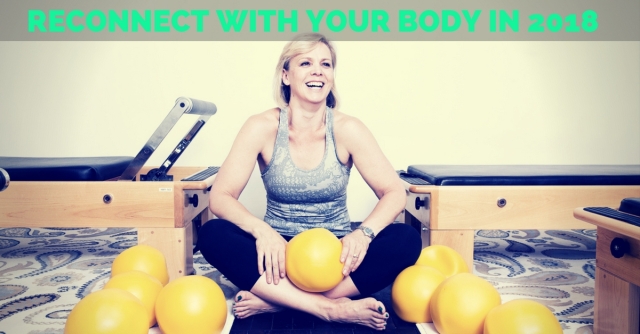
Welcome! I’m Christine Binnendyk, a Pilates trainer and movement geek based in Portland, Oregon.
Are you ready for bit of “me time” in 2018? Do you want to feel relaxed and nurtured as well as energized and uplifted? My private Pilates studio is the perfect place to reconnect with your body.
Make a commitment to yourself by joining a weekly Pilates equipment class that builds your ability and your confidence step-by-step. By the end of 10 weeks, you’ll be longer, stronger, fitter, happier. I’ve got your back!
WHAT MAKES MY STUDIO DIFFERENT?
Have you ever joined an exercise class and….fizzled out? Maybe you felt a little lost with the words and the movements, or you just didn’t see or feel any results in your first month?
Working out at my studio will be different.
- Everyone commits to a semester of work, which lasts 10 weeks. I have start dates 4x per year. You’ll come in the same day and time each week, so you’ll get to know your classmates a bit. Since classes are limited to a maximum of 8, that builds some camaraderie. Your new friends are happy to see you and happy to see you succeed. Really.
- All classes are taught by me, Christine Binnendyk. No drop-in teachers, no substitutes. We’ll get to know each other and you can count on me being there for you and understanding your body and its needs. I’ve been teaching Classical Pilates for 22 years and I love working with all kinds of bodies and all kinds of people! I’m patient, yet persistent. If repeating a concept or an instruction bothered me, I wouldn’t be teaching Pilates for a living!
- Portland Community College sponsors all of my group equipment classes. They handle my registration and you’ll run into lots of professors in class.
- Each week of class builds on the last, so you can learn systematically. Newbies begin with Level 1 starting with the vocabulary and concepts behind Classical Pilates. No worries, you’ll be moving from Day 1! Learning the “secret sauce” behind Pilates movements will give you results you can count on. You can take those concepts into other workouts and into the way you use your body in your daily life.
Level 1 options for Spring term 2018
- Mon 10:30am CRN 27725
- Wed 10:30am CRN 27728
- Fri Noon CRN 27726
- Sat 11am CRN 27727
- Register using the CRN’s above at http://www.PCC.edu. Details here : https://www.pcc.edu/community/about/registration.html
.
- As you progress, you have the option of moving on to Level 2, where the class moves a bit faster and we add more exercises to your workout. Level 3 is for experienced Pilates geeks with the fasted paced movements — this class involves a bit more weight-bearing on the hands. It’s always up to you what level to attend each semester and I can give you an opportunity to try out the next level before you commit to your next semester.
- What can you expect for results? In the first 2 weeks, you’ll upgrade your posture in your daily life. You’ll start holding yourself differently and that leads to fewer aches and pains. Within the first month, you’ll feel stronger and surer of your core (in Pilates, we call that you Powerhouse.) By the end of you first semester with me, you’ll be moving differently and you’ll feel more confident and fluid in your movements. Many people report that they’re smaller in diameter, yet taller in stance. Yep, that’s common.
- If you’re 62 or older, Portland Community College will give you a 50% tuition break.
- If you work for PCC, you can use your education credits toward Pilates classes with me.
- Life happens: I have a system for missed classes, so no worries if you have a trip planned or you get sick. You’ll likely be able to find a make-up slot within the semester.
WHAT I DO
I help people improve the way they move, so that they can enjoy life.
Primarily, I do this using Pilates training, but over the last 20+ years of working with bodies, I’ve accumulated many additional tools and techniques that I use with my clients.
I teach both Private Sessions and Group Classes. If you have a “situation” – a diagnosed issue or anything that slows you down please schedule a private session so that I can assess your body – I can help you so much more if we both understand what’s going on. Many of my clients take group classes AND do private sessions.
Private Appointments Group Equipment Classes
List of conditions that I’m trained to work with:
| Achilles Tendonitis | Low back pain |
| Ankle pain | Low Bone Density |
| Arch Pain / Arch Strain | Lumbar disk disease |
| Arthritis | Lymph edema |
| Balance Issues | Mid-back pain |
| Breast Cancer | Multiple Sclerosis |
| Bulging Discs | Neck pain |
| Bunions | Nerve Impingments |
| Cancers of all types | Neurological Conditions |
| Carpal tunnel syndrome | Neuro-muscular disease |
| Chronic Fatigue Syndrome | Neuropathy |
| Compressed Discs | Osteo-arthritis |
| Compression fracture | Osteopenia |
| Degenerative disk disease | Osteoporosis |
| Diastasis Recti | Parkinson’s Disease |
| Disc Compression | Plantar Fasciitis |
| Elbow pain | Post- Stroke |
| Epicondylitis | Post-natal |
| Fibromyalgia | Pre & Post rehab: hip replacement |
| Foot pain | Pre & Post rehab: knee replacement |
| Frozen Shoulder | Pre & Post rehab: shoulder replacement |
| Gait issues | Pre-natal |
| Golfer’s Elbow | Rheumatoid Arthritis |
| Hand pain | Sciatica |
| Herniated Discs | Scoliosis |
| Hip Pain | Shin Splints |
| Hip replacement | Shoulder pain |
| Jaw pain | Shoulder replacement |
| Joint Hypermobility | Spinal stenosis |
| Knee Pain | Spondylolisthesis |
| Knee replacement | Tennis Elbow |
| Kyphosis | Upper back pain |
A LITTLE HISTORY
Modern day Pilates was invented by a real person, Joseph Pilates, in the early 1900’s. There are lots of legends abut Joe; some are true and some are not. Did he invent the mat exercises? Probably not – people around the world were doing Turner Exercises devised during the Physical Culture era well before Joe’s time, and many of those made their way into the Pilates lexicon. (If you’ve clicked that link: skip down to the section “Athletic clubs and sports” and read on from there.)

Physical Culture in the late 1800s: all the cool kids were doing it at the YMCA.
He DID invent most of the Pilates exercise machines that we see in modern Pilates studios: the Universal Reformer, the Trapeze Table, the Wunda Chair and many more.
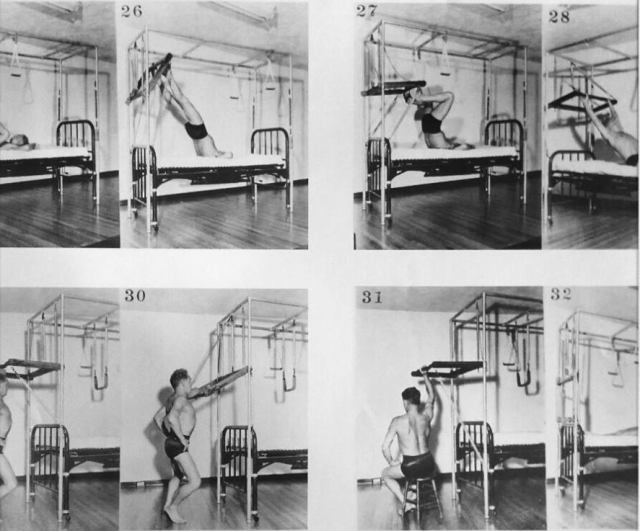
Joe’s “Bednasium” is very similar to his Trapeze table, aka “The Cadillac”
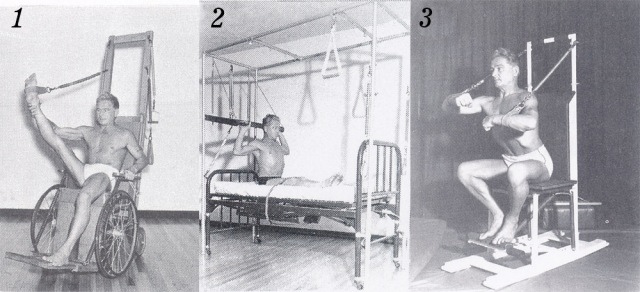
Joe constantly tweaked his inventions and sought out different markets for them

The Universal Reformer is the most well known of Joe’s inventions. Think Pilates isn’t athletic — try doing a pistol squat on a moving platform, like Joe is doing here!

One the first pieces of Pilates equipment I acquired as a student: the Spine Corrector!
Your first piece of Pilates trivia: Joe didn’t call his method “Pilates.” That would be like me saying, “let’s do Binnendyk.” You’d think that was weird, right? Joe called his method Contrology, the art of Control. When you become a Pilates geek like, you become a Contrologist.
HOW IS PILATES DIFFERENT THAN OTHER TYPES OF EXERCISE?
Each Pilates exercise incorporates your entire body. When one thing moves, everything else stays still. To the naked eye, the exercises may look easy, but keeping your torso still while your legs are moving is not easy. It takes control. We never isolate; we always work the entire system. Every exercise uses your core and more.
Most other exercise forms focus on concentric contraction — the shortening of muscles while they work. Pilates focuses on eccentric contraction, which asks a muscle to work while in a lengthened position. You guessed it: those lengthened muscles look flatter while still being wicked strong.
The machines you’ll use in Pilates support and assist you – they can make exercises easier or harder. They’ll also help you notice where your body has become imbalanced or asymmetrical. Once you notice the imbalances, we can fix them. We focus on body alignment that you’ll use in your everyday life. And we focus on getting you feeling balanced, energetic and eager to get into the game of life.
WHAT’S THE DIFFERENCE BETWEEN PRIVATE TRAINING AND GROUP CLASSES
Private training focuses on your body’s specific needs; you can book one-on-one sessions with me, or two-on-one sessions. People always progress more quickly in private training because all of the exercises are selected specifically for you and your needs.
Group training offers camaraderie in a small group of up to 8 participants. My Group classes are offered on semester basis –you are committing to a 10-week series that progresses over the course of the semester. Group classes cover exercises selected for benefit of everyone in the group.
WHO I WORK WITH
Privately, I work with a wide range of people from professional and elite level athletes to performers to folks rehabbing from illness or injury. From a sport perspective, I have experience working with: football, baseball, soccer and hockey players; marathon and ultra-runners, triathletes, skeleton racers, fencers, mountain climbers and equestrians.
Got a condition and you’d like to work with someone who’s seen it before? See my list under WHAT I DO. I’ve spent much time and travel getting training and experience working with many conditions. Occasionally, someone walks in with something I haven’t seen before. I’ll give you my honest opinion on whether I’m a good fit for you. If I’m not, I’ll likely be able to point to someone who’d be a better fit.
In Group Classes, you’ll work out amongst a diverse crowd of Portland-based professionals: authors, doctors, professors, artists, and more.
HOW IS PILATES COMPLEMENTARY TO PHYSICAL THERAPY, CHIROPRACTIC, MASSAGE AND OSTEOPATHIC WORK?
Physical Therapy treats disease, injury or deformity using physical methods rather than drugs or surgery. Most PT’s accept insurance, which may require them to focus on a specific issue, rather than your whole body.
Chiropractic treatment uses manual alignment of joints, especially those in the spinal column, to address disorders by affecting the nerves, muscles, and organs. Your chiropractor may recommend specific exercises to help you “hold” your adjustments, but they don’t typically put you through a workout.
Massage involves manipulating soft tissues of the body to relieve tension or pain. Your LMT (licensed massage therapist) may recommend specific stretches or strengthening exercises, but they don’t typically spend a lot of time working through either of these with you.
Osteopathy is a form of manual medicine that treats and strengthens the musculoskeletal framework, including joints, muscles and the spine, to re-set your nervous, circulatory and lymphatic systems. Your Osteopath can recommend exercises, stretches and other techniques to help your body stay in balance; they don’t often spend much of your session doing this.
Pilates is smart exercise that focuses on bringing all of your bones and muscles into balance – the front and back body work equally, the right and left body work equally, the lower and upper body work equally. That balance takes away the tension that most people feel when some muscles are working too hard, and some aren’t working at all. This balanced approach complements other modalities like PT, Chiro, Massage and Osteopathy. Pilates doesn’t beat you up, it gives you the strength, flexibility and mobility to take on your life. The balance that Pilates creates can make all of the other modalities work even better. Psst: if you’re attending group classes, you’ll find practitioners of these modalities in class with you!
MY BACKGROUND
I’m Classically trained by Pilates elder Romana Kryzanowska. She is credited as being the person who studied and worked directly with Joe for the longest period of time. I’m told that when he passed away in 1967, his wife asked Romana to carry on his legacy. I learned from her how to teach the way that Joe taught, which was a fabulous place to start helping people with their bodies.
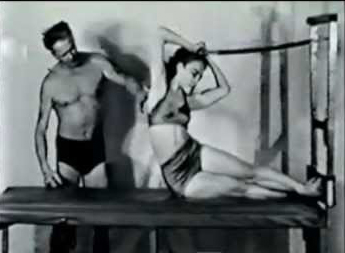
Romana, about age 19, working with Joe on a Tower unit. We have these in the Effortless Movement studio!
After a 3-year apprenticeship in the 1990’s under Romana Kryzanowska in Evanston IL, I traveled, studied more and eventually moved to the west coast. My Classical continuing education included stints with other Pilates elders — Ron Fletcher, Kathy Grant, Jay Grimes and Mary Bowen.
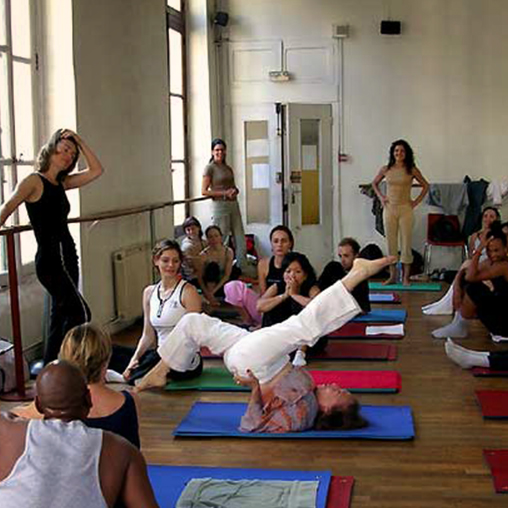
Romana demonstrating “Bicycle” — she’s in her late 70’s in this photo
My Contemporary continuing education has focused on working with physical therapists who use Pilates to address all types of physical issues. We’ve learned things about the human body since Joe passed in 1967; I think it’s important to keep abreast of new findings. “Contemporary Pilates” often follows a different structure than “Classical Pilates” — I feel fortunate that I’ve been trained in both styles and have the ability to choose what I think will work best for my clients.
2017 marks my 22nd year of teaching Pilates. My dear teacher, Romana, passed away just a few years ago at age 80. I hope to enjoy traveling and teaching for as many years as she did. Yep, she traveled, wore heels and drank champagne until pretty close to the end. Pilates was a key to her longevity; I’m hoping to enjoy the same and to pass it on to you too!
